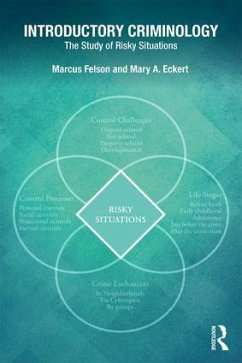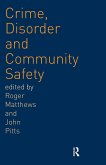- Broschiertes Buch
- Merkliste
- Auf die Merkliste
- Bewerten Bewerten
- Teilen
- Produkt teilen
- Produkterinnerung
- Produkterinnerung
Introductory Criminology: The Study of Risky Situations presents, in short, readable chapters, a narration encompassing diverse situations in which crime is likely to occur, and explores the likely causes of and societal responses to criminal events.
Andere Kunden interessierten sich auch für
![Communities, Crime and Social Capital in Contemporary China Communities, Crime and Social Capital in Contemporary China]() Lena Y ZhongCommunities, Crime and Social Capital in Contemporary China40,99 €
Lena Y ZhongCommunities, Crime and Social Capital in Contemporary China40,99 €![Research Methods for Criminal Justice and Criminology Research Methods for Criminal Justice and Criminology]() Christine TartaroResearch Methods for Criminal Justice and Criminology62,99 €
Christine TartaroResearch Methods for Criminal Justice and Criminology62,99 €![Racial Criminalization of Migrants in the 21st Century Racial Criminalization of Migrants in the 21st Century]() Racial Criminalization of Migrants in the 21st Century70,99 €
Racial Criminalization of Migrants in the 21st Century70,99 €![Crime, Disorder and Community Safety Crime, Disorder and Community Safety]() Roger MatthewsCrime, Disorder and Community Safety73,99 €
Roger MatthewsCrime, Disorder and Community Safety73,99 €![Racism and Racial Surveillance Racism and Racial Surveillance]() Racism and Racial Surveillance55,99 €
Racism and Racial Surveillance55,99 €![Introduction to Criminology Introduction to Criminology]() Frank E HaganIntroduction to Criminology191,99 €
Frank E HaganIntroduction to Criminology191,99 €![Rape in the Nordic Countries Rape in the Nordic Countries]() Rape in the Nordic Countries55,99 €
Rape in the Nordic Countries55,99 €-
-
-
Introductory Criminology: The Study of Risky Situations presents, in short, readable chapters, a narration encompassing diverse situations in which crime is likely to occur, and explores the likely causes of and societal responses to criminal events.
Hinweis: Dieser Artikel kann nur an eine deutsche Lieferadresse ausgeliefert werden.
Hinweis: Dieser Artikel kann nur an eine deutsche Lieferadresse ausgeliefert werden.
Produktdetails
- Produktdetails
- Verlag: Taylor & Francis
- Seitenzahl: 450
- Erscheinungstermin: 4. Dezember 2017
- Englisch
- Abmessung: 232mm x 188mm x 24mm
- Gewicht: 998g
- ISBN-13: 9781138668249
- ISBN-10: 1138668249
- Artikelnr.: 50294539
- Herstellerkennzeichnung
- Libri GmbH
- Europaallee 1
- 36244 Bad Hersfeld
- gpsr@libri.de
- Verlag: Taylor & Francis
- Seitenzahl: 450
- Erscheinungstermin: 4. Dezember 2017
- Englisch
- Abmessung: 232mm x 188mm x 24mm
- Gewicht: 998g
- ISBN-13: 9781138668249
- ISBN-10: 1138668249
- Artikelnr.: 50294539
- Herstellerkennzeichnung
- Libri GmbH
- Europaallee 1
- 36244 Bad Hersfeld
- gpsr@libri.de
Marcus Felson is the originator of the routine activity approach and author of Crime and Everyday Life. He has also authored Crime and Nature, and he serves as a professor at Texas State University in San Marcos, Texas. He has a B.A. from the University of Chicago and an M.A. and Ph.D. from the University of Michigan. He has received the 2014 Honoris Causa from the Universidad Miguel Hernandez in Spain, and he has been given the Ronald Clarke Award by the Environmental Criminology and Crime Analysis group and the Paul Tappan Award by the Western Society of Criminology. He has been a guest lecturer in Argentina, Australia, Belgium, Brazil, Canada, Chile, China, Denmark, El Salvador, England, Finland, France, Germany, Hong Kong, Hungary, Italy, Japan, Mexico, the Netherlands, New Zealand, Norway, Poland, Scotland, South Africa, Spain, Sweden, and Switzerland. He has applied routine activity thinking to many topics, including theft, violence, sexual abuse, white-collar crime, and corruption. Two books honoring Professor Felson's work have been published, one in English and another in Spanish. Mary A. Eckert has devoted an active career to applied research in criminal justice and program evaluation. She has an M.A. and Ph.D. from New York University. Her B.A. is from the College of New Rochelle. Dr. Eckert served as Research Director of the New York City Criminal Justice Agency, Inc., where she authored many research reports and guided that agency's diverse research agenda, including work on pretrial risk assessment, court case processing, and evaluation of alternative-to-incarceration programs. She then served in the New Jersey Office of the Attorney General, with a special focus on statistical evaluation of vehicle stops to assist the New Jersey State Police in reducing the potential for racial profiling. Her work has been recognized by the New York Association of Pretrial Service Agencies and the State of New Jersey. She has also served as an adjunct professor at New York University, Montclair State University, and Texas State University. Marcus Felson's wife and life partner, this book is her second collaboration with her husband.
Getting Started. Part 1. The Crime Challenge. Unit 1.1 The Need to Control
Disputes. Unit 1.2. Containing Sexual Temptations. Unit 1.3 Protecting
Property. Unit 1.4 Safeguarding Children. Perspective on Part 1. Part 2.
Four Types of Crime Control. Unit 2.1 Personal Controls. Unit 2.2 Social
Controls. Unit 2.3 Situational Controls. Unit 2.4 Formal Controls.
Perspective on Part 2. Part 3. Realistic Justice. Unit 3.l Assigning
Responsibility. Unit 3.2 Realistic Policing. Unit 3.3 Realistic Court
Activity. Unit 3.4 Realistic Sanctions. Unit 3.5 Efforts and Realities.
Unit 3.6 Practical Crime Data. Perspective on Part 3. Part 4. Risky Ages.
Unit 4.1 The Teenage Brain Unit 4.2 Teenage Volatility. Unit 4.3 Peer
Influences. Unit 4.4 Situational Inducements. Unit 4.5 Time with Peers.
Perspective on Part 4. Part 5. Overt Crime Areas. Unit 5.1 Tough
Neighborhoods. Unit 5.2 Cohesion vs. Intimidation. Unit 5.3 Exclusion. Unit
5.4 Concentration. Unit 5.5 Accommodation. Unit 5.6 The Pathway to Decay.
Unit 5.7 Mapping Crime. Perspective on Part 5. Part 6. Risky Settings for
Women. Unit 6.1 The Policy Challenge. Unit 6.2 Risky Streets. Unit 6.3
Risky Homes. Unit 6.4 Risky Nights. Perspective on Part 6. Part 7. Crime
Enhancers. Unit 7.1 Crime in Groups. Unit 7.2 Crime via Cyberspace.
Perspective on Part 7. Wrapping Up. Index.
Disputes. Unit 1.2. Containing Sexual Temptations. Unit 1.3 Protecting
Property. Unit 1.4 Safeguarding Children. Perspective on Part 1. Part 2.
Four Types of Crime Control. Unit 2.1 Personal Controls. Unit 2.2 Social
Controls. Unit 2.3 Situational Controls. Unit 2.4 Formal Controls.
Perspective on Part 2. Part 3. Realistic Justice. Unit 3.l Assigning
Responsibility. Unit 3.2 Realistic Policing. Unit 3.3 Realistic Court
Activity. Unit 3.4 Realistic Sanctions. Unit 3.5 Efforts and Realities.
Unit 3.6 Practical Crime Data. Perspective on Part 3. Part 4. Risky Ages.
Unit 4.1 The Teenage Brain Unit 4.2 Teenage Volatility. Unit 4.3 Peer
Influences. Unit 4.4 Situational Inducements. Unit 4.5 Time with Peers.
Perspective on Part 4. Part 5. Overt Crime Areas. Unit 5.1 Tough
Neighborhoods. Unit 5.2 Cohesion vs. Intimidation. Unit 5.3 Exclusion. Unit
5.4 Concentration. Unit 5.5 Accommodation. Unit 5.6 The Pathway to Decay.
Unit 5.7 Mapping Crime. Perspective on Part 5. Part 6. Risky Settings for
Women. Unit 6.1 The Policy Challenge. Unit 6.2 Risky Streets. Unit 6.3
Risky Homes. Unit 6.4 Risky Nights. Perspective on Part 6. Part 7. Crime
Enhancers. Unit 7.1 Crime in Groups. Unit 7.2 Crime via Cyberspace.
Perspective on Part 7. Wrapping Up. Index.
Getting Started. Part 1. The Crime Challenge. Unit 1.1 The Need to Control
Disputes. Unit 1.2. Containing Sexual Temptations. Unit 1.3 Protecting
Property. Unit 1.4 Safeguarding Children. Perspective on Part 1. Part 2.
Four Types of Crime Control. Unit 2.1 Personal Controls. Unit 2.2 Social
Controls. Unit 2.3 Situational Controls. Unit 2.4 Formal Controls.
Perspective on Part 2. Part 3. Realistic Justice. Unit 3.l Assigning
Responsibility. Unit 3.2 Realistic Policing. Unit 3.3 Realistic Court
Activity. Unit 3.4 Realistic Sanctions. Unit 3.5 Efforts and Realities.
Unit 3.6 Practical Crime Data. Perspective on Part 3. Part 4. Risky Ages.
Unit 4.1 The Teenage Brain Unit 4.2 Teenage Volatility. Unit 4.3 Peer
Influences. Unit 4.4 Situational Inducements. Unit 4.5 Time with Peers.
Perspective on Part 4. Part 5. Overt Crime Areas. Unit 5.1 Tough
Neighborhoods. Unit 5.2 Cohesion vs. Intimidation. Unit 5.3 Exclusion. Unit
5.4 Concentration. Unit 5.5 Accommodation. Unit 5.6 The Pathway to Decay.
Unit 5.7 Mapping Crime. Perspective on Part 5. Part 6. Risky Settings for
Women. Unit 6.1 The Policy Challenge. Unit 6.2 Risky Streets. Unit 6.3
Risky Homes. Unit 6.4 Risky Nights. Perspective on Part 6. Part 7. Crime
Enhancers. Unit 7.1 Crime in Groups. Unit 7.2 Crime via Cyberspace.
Perspective on Part 7. Wrapping Up. Index.
Disputes. Unit 1.2. Containing Sexual Temptations. Unit 1.3 Protecting
Property. Unit 1.4 Safeguarding Children. Perspective on Part 1. Part 2.
Four Types of Crime Control. Unit 2.1 Personal Controls. Unit 2.2 Social
Controls. Unit 2.3 Situational Controls. Unit 2.4 Formal Controls.
Perspective on Part 2. Part 3. Realistic Justice. Unit 3.l Assigning
Responsibility. Unit 3.2 Realistic Policing. Unit 3.3 Realistic Court
Activity. Unit 3.4 Realistic Sanctions. Unit 3.5 Efforts and Realities.
Unit 3.6 Practical Crime Data. Perspective on Part 3. Part 4. Risky Ages.
Unit 4.1 The Teenage Brain Unit 4.2 Teenage Volatility. Unit 4.3 Peer
Influences. Unit 4.4 Situational Inducements. Unit 4.5 Time with Peers.
Perspective on Part 4. Part 5. Overt Crime Areas. Unit 5.1 Tough
Neighborhoods. Unit 5.2 Cohesion vs. Intimidation. Unit 5.3 Exclusion. Unit
5.4 Concentration. Unit 5.5 Accommodation. Unit 5.6 The Pathway to Decay.
Unit 5.7 Mapping Crime. Perspective on Part 5. Part 6. Risky Settings for
Women. Unit 6.1 The Policy Challenge. Unit 6.2 Risky Streets. Unit 6.3
Risky Homes. Unit 6.4 Risky Nights. Perspective on Part 6. Part 7. Crime
Enhancers. Unit 7.1 Crime in Groups. Unit 7.2 Crime via Cyberspace.
Perspective on Part 7. Wrapping Up. Index.








